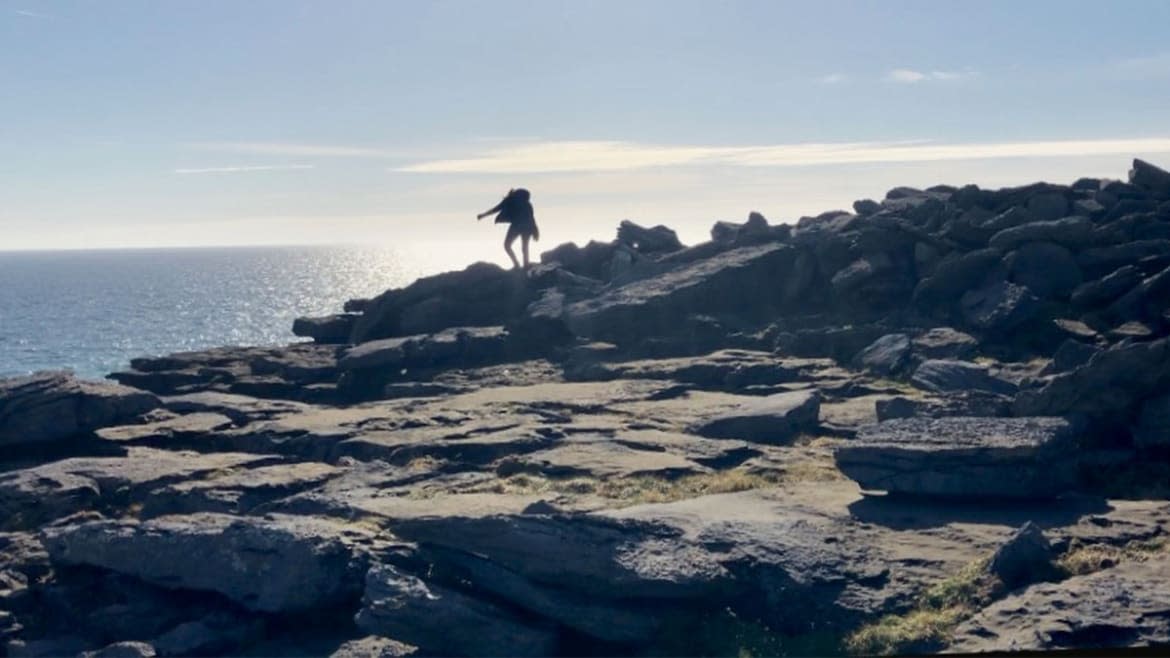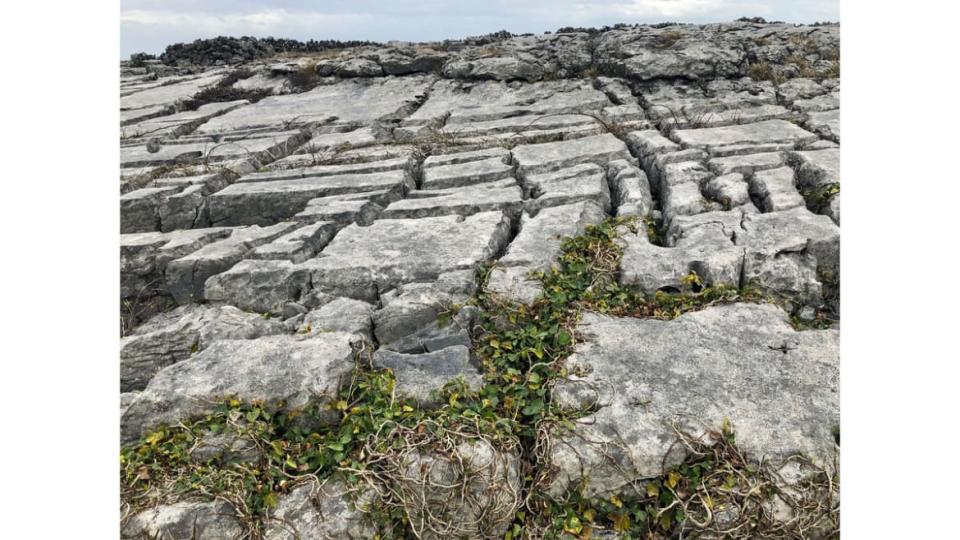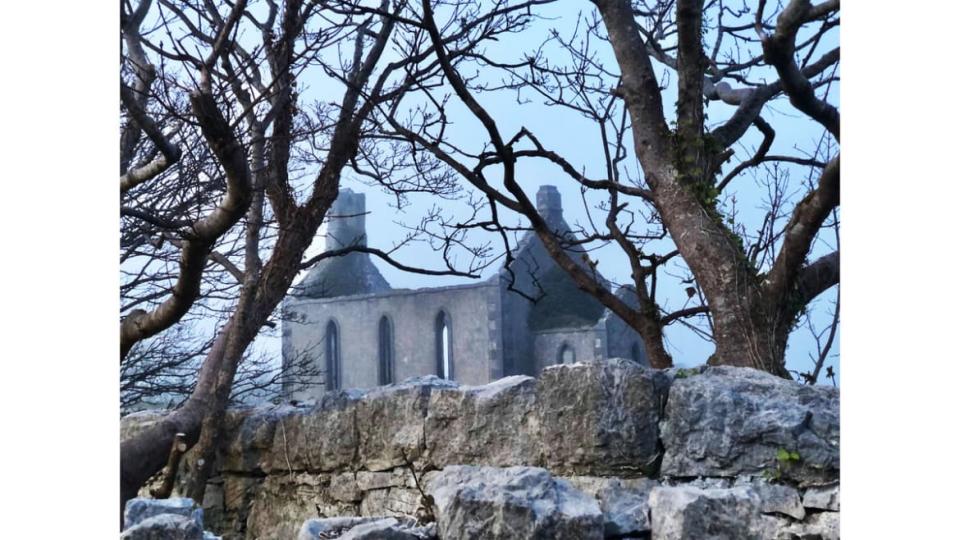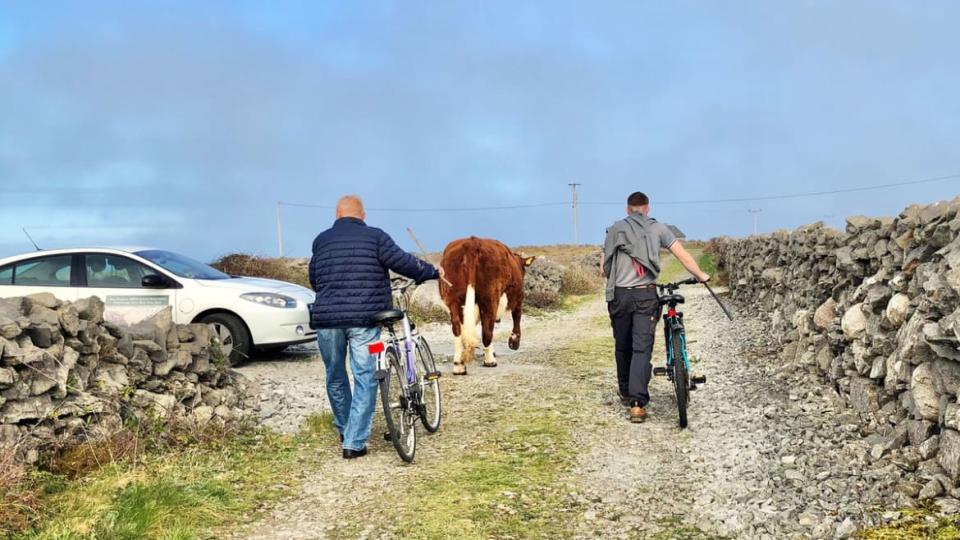The Irish Islands on the Edge of the World

- Oops!Something went wrong.Please try again later.
“I don’t know what I’m doing here,” my wife said, almost in tears. We were in our room at the bed and breakfast where we had just arrived on a chill, wet April morning after a bumpy ferry ride that began in Doolin, on the western coast of Ireland, and ended some half hour later at Inishmore, the largest of the three Aran Islands that bestride the approach to the Bay of Galway.
We’d been traveling in Ireland for about a week at that point, and I’d heard no complaints about the itinerary I’d put together (she’d never visited the country before, but I had, so it fell to me to plan the trip). So her unhappiness took me a little by surprise and made me a little defensive. I’d been to the islands only once, many years before, but my day there had lodged in my memory.
There was something compelling, haunting even, about the Aran Islands, such that I couldn’t get the place, a place like no other in my experience, out of my head, and I had always wanted to return to see if I could figure out what it was that wouldn’t let me go. And of course, I wanted my wife to feel the same sense of mystery, maybe even enchantment.
What I hadn’t counted on was filthy weather, a long walk from the dock with two suitcases and no certain sense of exactly where our B&B was located, and then, upon finally arriving, finding ourselves in a room just big enough for two people who are getting along extremely well. Clearly, first impressions were not working in my favor.
So we did what any smart couple who aren’t getting along in a small room in a strange place should do: we went for a long walk.
We walked aimlessly for about an hour, along the sea wall that skirts the bay at Kilronan, the largest town on Inishmore, which is the largest of the three Aran Islands less than 10 miles off the western coast of Ireland. Leaving the road, we hopped down to the sandy beach exposed at low tide. After a quarter mile or so, we cut back up to the road and then began following a series of winding lanes inland, through Kilronan’s backyards and onward to the island’s interior.
‘The Banshees of Inisherin’: Inside the Most Beautiful, Bizarre Movie Shoot Ever
Somewhere along the way, the rain faded to mist and then vanished entirely. As the clouds broke up, the sky itself seemed to rise as it lightened, and so did our mood. I don’t think we spoke more than a dozen sentences on that walk, but when we were done, we had found a durable harmony that, minus a bump or two, stayed with us for our three days on Inishmore.
I’m not sure why, other than magical thinking, I should have expected anyone visiting the islands for the first time to instantly embrace them. They’re rocky, windy places, with not many people and even fewer trees. I wouldn’t call the landscape inhospitable—to me it’s intoxicating—but I admit it takes some getting used to.
Somewhere on that first walk, I began to realize that it was unfair to bring someone to this place and expect them to instantly embrace it without any preparation. My wife did not possess even my very limited experience of the place, an experience that, 40 years on, left me craving to know more. It was my obsession, not hers, and it’s never a good idea to try forcing your obsessions on other people.
She had never read Irish playwright J. M. Synge’s brilliant memoir of his time living on the islands (amazingly current considering it was written more than a century ago), never seen Robert Flaherty’s 1934 film Man of Aran, the somewhat fictionalized documentary about the rough life of fishermen and their families. And most important, unlike me, she had not spent nearly 40 years thinking about the islands and dreaming of going back.
I first visited Aran in January 1973. I was there with a college group that spent the month touring Ireland studying history and literature. We took a day trip to Inishmore when there was only the mail boat once or twice a day. Today there are ferries running several times of day and docking at all three islands, and the Aran Islands are all busy tourist destinations. Many of the cottages abandoned by the dwindling local population (down to 1,226 from a high of 3,500 in 1841) have become summer rentals.
Fifty years ago, it was a different place with a different feel: more cut off, more lonesome. There was no crowd of horse-drawn tourist carts jostling for your business as you disembarked the ferry, and there were no bike rental shops. Surely there must have been a shop or two to sell you an Aran sweater, but if there was I don’t recall it (I bought mine at a Dublin department store).
I have two vivid memories from that day in 1973. First, upon arriving, we stopped at one of the two smaller islands before docking at Inishmore. I don’t know whether we stopped at Inishmaan or Inisheer, but wherever we stopped didn’t have a dock. Mail and freight and people were transported from the boat to the island by curraghs, which are hardly more than broad-beamed canoes with tarred canvas bottoms but piloted by the islands’ natives with astonishing skill. While we watched from the upper deck, a door was opened in the side of the boat and from it emerged a double bed mattress and box spring that were then balanced as lightly as a crate of eggs on the curragh that had come alongside. The bed and springs dwarfed the little boat and the two men in it, who then accomplished what seemed to me nothing less than a miracle when they pivoted for shore and navigated the choppy bay with their cumbrous cargo balanced athwart, high and dry the whole way.
I had no way of knowing at the time, but the delivery we watched that day was a means of transport that went back at least a century.
In 1895, the Anglo-Irish writers Edith Somerville and Violet Martin (who wrote professionally as Somerville & Ross) visited Inishmore for a fortnight, a trip chronicled in their essay “An Outpost of Ireland.” Their arrival, almost 80 years before mine, was eerily similar: “Round the steamer flocked battered punts and tarred canvas curraghs with their bows high out of the water; tanned faces, puckered by the sunlight, stared up from them, and in a storm of Irish the process of disembarking began—the phrase but feebly expresses the spectacle of a kitchen table lowered from the deck and laid on its back in a curragh, or the feat of placing an old woman sitting in the table with a gander in her lap. The curragh has no keel, and a sneeze is rightly believed to be fatal to its equilibrium, but an old Aran woman and an Aran gander can rush in where Sir Isaac Newton might fear to tread.”
That essay also includes a throwaway line from an innkeeper in Galway, the closest city of any size on the Irish mainland: “Miss Gerraghty then stated that them Aran people had a way of their own and a sense of their own, like the Indians…” Neither Miss Gerraghty nor Somerville & Ross can explain precisely what is meant here, but in the context of the essay, it’s plain enough: comparing Aran to other places will not get you far. Both the islands and the islanders are enigmatically incomparable.
In my second memory, I am alone on the island, where I did little more than walk a bit that day, mostly along the bay. But at some point, I must have made it to the ocean side of Inishmore, which is mostly nine miles of cliff from end to end, because I distinctly recall thinking, as I stared out across the Atlantic, like the monks and saints and assorted pagans who centuries ago built the religious shrines and the forts that line this coast: I’m standing at the edge of the world.
My sole memories of that first visit were, admittedly, rather inconsequential and, in the second case, maybe a little histrionic. The point is, they did not fade. As time passed, I found that I was thinking more, not less, about the Aran Islands, until at some point I made up my mind that I would return.

For the longest time, I could not explain my attraction. If I spoke of it, I’d mumble things like, their allure is grounded in their uniqueness: I’d never seen anything like them and never have since. True enough, but that’s not the whole of it. When I made that first trip to Ireland, I was barely 21, and the charter flight from North Carolina to Ireland was the first time I’d flown in my life. I had no points of comparison for any of what I saw. It took me decades of travel to understand what I felt on that first trip, because different places elicit widely different responses in us, and it takes years to sort out the places that mean something to us from those that are merely beautiful. In the case of Inishmore, I know now what I could not know on the first trip: Inishmore is one of those places that I can’t call home but where I felt at home as soon as I set foot there.
My wife, being a little quicker on the uptake, had all this sorted for herself in under three hours after she arrived.
Even places as superficially inhospitable as the Aran Islands have such a power to enchant. People have gone there since before recorded history--the archeology on Inishmore is so ancient that experts cannot tell us with any assurance what certain massive stone structures on Aran were for. We do know that life on Aran has always been hard, and while that may be what initially appealed to the endless stream of monks and priests and saints who have journeyed there since St. Enda set foot on Aran in the fifth century, arduousness is not an attribute for most people. And yet, people came and they stayed. And they never stop trying to make sense of the place, especially the writers (well, this is Ireland).
Of all the writers who have tried to unriddle Aran’s mystery and attraction, two came very close. First is the aforementioned John Millington Synge, whose The Aran Islands describes his time spent living on Aran around the turn of the last century. Synge’s short, eloquent book, published in 1907, remains Aran’s most vivid and accessible introduction. And at the other end of the 20th century, the artist, author, and mapmaker extraordinaire Tim Robinson published his monumental two-volume Stones of Aran, exploring Inishmore mile by mile, and sometimes foot by foot. The first volume, Pilgrimage, works its way around the island’s perimeter, and Labyrinth explores the interior. The books blend history, natural history, mythology, geography, and personal experience into a singular work of art that somehow never loses its utility: Both volumes make excellent travel guides.
Some fret that all the words spilled on interpreting the islands have so muddied our perception that we can no longer see the place plainly, that its essence has been suffocated by some bastard merger of analysis and romance. This pearl-clutching ignores the fact that while Synge and Robinson and all the rest might supply the visions that lure you to the place, they only prepare you a little for what you find when you arrive.
A more foursquare acknowledgment of the uncrackable mystery inside Aran’s allure may be found in the writing of Cormac mac Cuillenain, the 10th-century bishop-king of Cashel, who wrote that Aran’s saints were innumerable and that Aran was one of the four holiest places on Earth, along with Rome, Jerusalem, and the Garden of Eden, and furthermore that no angel ever came to Ireland without calling on Aran.
Talking about the spiritual aspects of a place is one of the best ways I know to clear a room, so let it suffice that physical manifestations of worship, the remnants of the early Christian and Medieval eras, when monks and the more than occasional saint held Aran as a place of pilgrimage, sanctuary, and penance, are everywhere across these islands. Tombs, shrines, and the partial walls of ancient churches crop up across the landscape like the skeletons of an ancient age thrusting into the present and refusing to be ignored.
None of the several monasteries built by St. Enda and his successors managed to completely survive Cromwell’s army in the 17th century, when friaries and other holy spots were dismantled and their stones used to build fortifications, which in their turn have been taken apart and redeployed into the ubiquitous stone walls of the present. Everything on Aran is sooner or later repurposed and reused.

Around the little town of Kilmurvey, we ran headlong into a perfect distillation of the island’s overlaid historical eras. To the south and west and high above the town, there is Dún Aonghasa, a prehistoric three-sided stone enclosure whose fourth wall is the vertiginous cliffside, here towering 300 feet above the Atlantic. It is a massive structure, enclosing some 14 acres, its walls 13 feet thick at some points. It is also immensely mysterious: archeologists cannot agree on its purpose. A fort? (Dún means fort in Irish) A pen for cattle? A place of worship? Some combination? Enough of something to cast a considerable spell of quietude even today. Standing on the stony plain cupped in the towering stones’ mute embrace, one feels—the word is my wife’s and I can’t do better—humbled.
Not a quarter mile away to the northeast, in the shadow of the steep hill crowned by Dún Aonghasa, sits Teampall Mhic Duach, a little stone church, long bereft of a roof, built and amended throughout the Middle Ages. And right alongside that church is a Big House, as the 18th and 19th century homes of British and Anglo-Irish landlords were called. So, three major eras of Irish history--four if you count the modern era, in which the Big House has become a small hotel--tumble all over each other in tight proximity.
“If Ireland is intriguing as being an island off the west of Europe,” Tim Robinson wrote, “then Aran, as an island off the west of Ireland, is still more so: it is Ireland raised to the power of two. Whether the grain of wonderful truth in this can survive the trampling of the hundred thousand tourists who now visit the islands each year, remains to be seen.”
Since my first visit in 1973, the old once-a-day ferries have become hourly, and when you disembark, you are met by competing bike-hire companies and pony-trap tour guides. There are several pubs, restaurants, clothing shops, and at least one pop-up coffee shop. You can see cell towers against the horizon, and each island has its own airstrip. Houses can be rented for the week or the season, and there are several small hotels, bed-and-breakfasts, and, lately, glamping.
The accusation that Aran is being spoiled by commercialization and modernity is not new. When J.M. Synge arrived on Inishmore in 1898, he was so appalled by what he considered modernization that he promptly moved on to the wilder precincts of the smaller, slightly more rustic island of Inishmaan.
The fact is, by almost any measure commercial development is still negligible on Inishmore, confined mostly to the town of Kilronan that borders the little harbor where the ferries tie up. A five-minute walk puts you in the countryside, where the cottages that sparsely line the roads could be 100 or even 200 years old. You share the road, when you share it at all, with day-tripping bikers, the horse-drawn carts hauling tourists (known locally as pony traps; the drivers are called jarvies), and the very occasional automobile. In many spots, the only way to tell what century you’re in is the sight of overhead electric lines lining the road.
Walk a mile or so and the houses thin and the trees vanish, the fields take over, until it’s nothing but fields, stones, sky, wind, and occasionally a cow or two, a few sheep, and here and there a donkey. The cattle are indifferent, and the sheep are shy, but the donkeys, humiliatingly shorn with their Moe Howard haircuts, are friendly to a fault, or maybe just hungry: one sidled up to the roadside fence where I was standing and, dispensing with introductions, quickly tried to eat my raincoat.

These islands aren’t far off the mainland, maybe 5 to 10 miles, and if you’re walking on the side of Inishmore that faces the mainland, you can easily see the mountains of Galway. This makes the feeling of isolation and separateness even more uncanny—you’re close but far away all at once—and your sense of space upon the island is likewise bent. The fields that stretch away in every direction are small, and all are bounded by low rock walls. It’s been estimated that on the three Aran Islands together (the largest is roughly the size of Manhattan) there are 1,000 miles of rock wall. And as these little postage-stamp-sized lots accumulate and multiply, the horizon somehow gets pushed farther and farther away, lending the gray-green landscape an unreal but nevertheless undeniable vastness.
Complicating the view, the fields are broken up randomly by bare limestone outcrops that are themselves often the size of fields, and sometimes the landscape turns to rock altogether, quilted and quartered like a sheet cake by glaciers and wind and rain, giving the place an almost lunar-surface loneliness. Somerville & Ross could also have been writing about Aran when describing a stretch of southern Irish landscape as a “country whose entire barrenness could only be explained on the hypothesis that it had been turned inside out to dry. So far it had failed to achieve even this result.”
On our last day, we hiked up to Dún Dúchathair, the Black Fort, another horseshoe-shaped enclosure at the cliff’s edge. It’s not a strenuous climb but you want to mind where you step, particularly the last quarter mile over uneven stony ground full of fissures and mini-crevasses just waiting to twist your ankle. It’s a treacherous stretch, but also beautiful: in the grooved and pitted limestone, wildflowers and ferns incubate and spring forth abundantly, sometimes clinging to the cliff’s edge itself. Species both Alpine and Mediterranean meet and flourish here in a micro-environment like no other, and the blooms in summer make this a paradise for butterflies.
It might seem fanciful if it were not so obviously true that this hermetic little world is like Aran in miniature: a unique environment, self-contained, related to the continent on whose edge it rides but “silent, enigmatic, apart,” as Somerville & Ross wrote. And yes, whose people have a “way of their own, and a sense of their own, like the Indians.” It’s quiet up there on the top of the cliff. The surf rumbles offstage, the breeze raises no ruckus. We sat there, our backs against the immense dry stone walls, the sun in our faces, as people have on this spot for hundreds of years, thousands maybe. We had no desire to get up and go home, no thought for the past and none for the future. We were happy, exactly where we were. Forty years after my first visit, it still felt like the edge of the world, and for the duration of that afternoon, the cares of that world belonged to someone else.
Get the Daily Beast's biggest scoops and scandals delivered right to your inbox. Sign up now.
Stay informed and gain unlimited access to the Daily Beast's unmatched reporting. Subscribe now.

